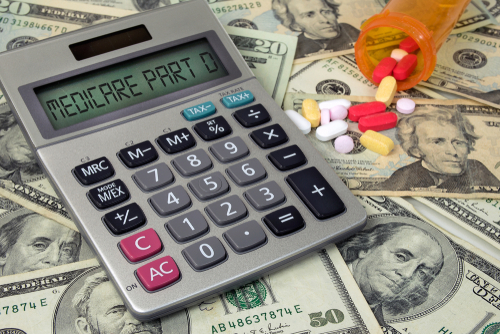Medicare offers two avenues through which you can get prescription drug coverage. This includes Medicare Part D or a Medicare Advantage plan with prescription drug coverage. Joining a plan with prescription drug coverage can help you get your medication cheaper. But, it is important to join when you’re first eligible.
Medicare Part D and Medicare Advantage
Medicare Part D and Medicare Advantage are two separate types of Medicare policies, but each can cover prescriptions.
Medicare Part D is Medicare’s prescription drug plan, and like Medicare Advantage, the premium varies from policy to policy. On average, a monthly Part D premium is $33.06. Part D has a deductible, but its deductible has varying costs as well. However, as of 2021, the deductible cannot be any higher than $445. For Medicare Advantage, the premiums can be as low as $0.
Medicare Advantage features prescription coverage, but that isn’t the only type of service it covers. Medicare Advantage has all the types of Medicare policies bundled into one policy. In fact, Medicare Advantage provides the same coverage as Original Medicare, which is Parts A and B and includes hospital and medical insurance, but also includes extra benefits such as:
- Dental coverage
- Vision coverage
- Hearing coverage
- Adult daycare services
- Gym memberships
- Nutrition and wellness programs
To enroll in both Part D and Medicare Advantage, you must first be enrolled in Original Medicare. You can actually get Part D as a standalone plan alongside your Original Medicare coverage, whereas Medicare Advantage is more or less seen as an alternative to Original Medicare that most likely already has prescription coverage as an added benefit.
There are several plans associated with Medicare Advantage, which include:
- Health Maintenance Organization (HMO) Plans
- Preferred Provider Organization (PPO) Plans
- Special Needs Plans (SNPs)
- Medicare Medical Savings Account (MSA) Plans
- Private Fee-For-Service (PFFS) Plans
In most cases, prescription drugs are covered under HMO and PPO plans, but SNPs are 100% required to provide this coverage.
How it works
Formularies and tiers refer to the list of medications covered, and their price range. Not every plan’s formulary is the same (hence why it is a good idea to compile a list of the medications you’re taking prior to signing up for a Part D policy). That being said, all Medicare Part D policies have to cover protected classes, such as medications for treating HIV and cancer. Part D will cover at least two drugs per prescription drug category it covers (e.g. antidepressants, immunosuppressants, anticonvulsants, etc.)
The list of covered medications is divided into tiers. The lower the tier, the more inexpensive a medication is. Here are the tiers:
- 1 – Generic and preferred (least expensive)
- 2 – Brand-name, preferred
- 3 – Brand-name, not preferred
- Specialty drugs (most expensive)
When you’re prescribed a medication, your Part D insurance will try to get you the generic version of that drug. If one doesn’t exist, your insurer may try to arrange for you to get a generic version of a different drug that treats the same condition. The objective is to get your medications in the lowest tier possible.
If you find that even with Part D coverage you are still struggling with affording your prescriptions, you might qualify for the Extra Help program, also known as the Part D Low-Income Subsidy. The Extra Help program will help you pay your Part D premium, as well as copayments, deductibles, and coinsurance. In most cases, those who qualify for Extra Help won’t have to pay their premium or deductible. However, if you qualify for full Extra Help, you shouldn’t have to pay anymore than $3.70 for each generic prescription, or $9.20 for a brand-name prescription as of 2021.
If you do not qualify for full Extra Help, there is a possibility that you could qualify for partial Extra Help. This means you would not have to pay more than 15% of the cost of your prescriptions.
Also, if you happen to be enrolled in Medicaid, you should also not have to pay anything for your prescriptions.
When you can do it
You can obtain a Medicare Part D plan during:
- Initial Enrollment Period – the time when you’re first eligible. It consists of the three months before the month of your 65th birthday, the month of your 65th birthday, and the three months after that.
- Open Enrollment Period – You can join, switch, or drop a Part D plan between October 15 and December 7. You can also join, switch, or drop a Medicare Advantage plan.
- Special Enrollment – You can get a Part D plan within 62 days of losing other prescription drug coverage without a late enrollment penalty.
Keep in mind that if you do not enroll in Part D or enroll in other creditable drug coverage as soon as you are eligible or during these periods, then you will have to pay a late enrollment penalty once you do enroll in Part D. This penalty is added onto your premium and will last for as long as you have Part D coverage. The penalty for enrolling late in Part D ultimately depends on the amount of time you went without Part D or other prescription drug coverage.
Get more out of your prescriptions
At Medicare Peace of Mind, we give you our best effort in signing you up with a Medicare Advantage or Part D policy that makes your prescriptions cost what they ought to. If you are interested in making this happen, or if you have any questions or concerns, please call us today at 970-233-0063.
We are dedicated to ensuring you are fully aware of all your coverage options and will walk you through the decision-making and enrollment process so you can get the coverage you need at the budget you want.




